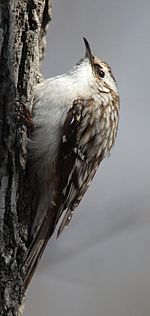
Treecreeper

The treecreepers are a family, Certhiidae, of small passerine birds, widespread in wooded regions of the Northern Hemisphere and sub-Saharan Africa. The family contains ten species in two genera, Certhia and Salpornis. Their plumage is dull-coloured, and as their name implies, they climb over the surface of trees in search of food. The family consists of two subfamilies, each with one genus. Their distinctive anatomical and behavioural characteristics are discussed in their respective articles. Some taxonomists place the nuthatches and treecreepers in a larger grouping with the wrens and gnatcatchers. This superfamily, the Certhioidea, was based on phylogenetic studies using mitochondrial and nuclear DNA, and was created to cover a clade of four families removed from a larger grouping of passerine birds, the Sylvioidea. The fossil record for this group appears to be restricted to a foot bone of an early Miocene bird from Bavaria which has been identified as an extinct representative of the climbing Certhioidea, a clade comprising the treecreepers, wallcreeper and nuthatches. It has been described as Certhiops rummeli. The genus name is derived from Ancient Greek kerthios, a small tree-dwelling bird described by Aristotle and others, and Latin familiaris, familiar or common. There are two other small bird families with treecreeper or creeper in their name, which are not closely related: The wallcreeper was originally described in the family Certhiidae but is now considered as more closely related to the nuthatches. The woodcreepers (subfamily Dendrocolaptinae) also have a similar name. Treecreepers measure from 12 to 18 centimetres in length. Their bills are gently down-curved and rather long, used for probing bark for insects and spiders. They often climb up tree trunks in a helical path, hopping with their feet together; their toes are long and tipped with strongly curved claws for gripping. The longer tails of the Certhia treecreepers are stiffened to use as a prop while climbing, but those of the spotted creeper are shorter and not stiffened. Their songs and calls are thin and high-pitched. Most species of treecreeper occur in the Palearctic and Indomalaya ecozones, from Western Europe to Japan and India. One species occurs in North America from Alaska to Nicaragua and another has a discontinuous distribution in sub-Saharan Africa and India. All species of treecreeper are found in forest and woodland habitats. The more northerly species are partly migratory, and those found in warmer climates are thought to be resident, although information is lacking for many species.
